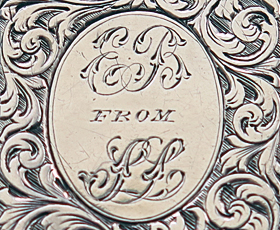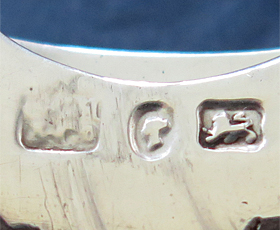Sterling Silver - Scroll Pattern
To date two slightly different versions of this needle case have been found. One was made by the Birmingham jeweler G. H. Johnstone &
Co. and the other one was made by another Birmingham jeweler named G. C. Haseler & Co.

G. H. Johnstone & Co. version - needle case (front and back)

G. C. Haseler & Co. version - needle case (front and back)

UK Patent 1868-3517 drawing
Design Details
Needle Case Type: |
Quadruple |
Patent/Registered to: |
William Avery, Redditch Needle Manufacturer and Albert Fenton of the same place, Machinist |
Patent/Design Representation #: |
Mechanical Patent: #3517 |
Patent/Design Registration Date: |
November 19, 1868 |
Location of Patent/Design Registration: |
British Library - Business and Intellectual Property Centre – London |
Reference #: |
1868-3517, Figures 7-10 |
Dimensions: |
3.3 x 7 |
Material: |
Silver |
Name Variations: |
a) G. H. Johnstone & Co - Birmingham
b) G. C. Haseler & Co - Birmingham |
Other Variations: |
See other Quadruples |
US Patent |
US 1870-98904 |
Note: The Birmingham Assay Office confirms that the hallmarks on these needle cases represent these jewelers.
Additional Photographs


Detail views of the front of the G. H. Johnstone & Co. version (photos from eBay)


Detail view of the front and back of the G. H. Johnstone & Co. version (photos from eBay)


Detail views of the back of the G. H. Johnstone & Co. version (photos from eBay)


Left: Detail view of the G. H. Johnstone & Co. version hallmark (photo from eBay). Right: Detailed view of the center decoration on the G. C. Haseler & Co. version.


Detail views of the design registation marks on the front and back of the G. C. Haseler & Co. version
Silver
Silver is a grayish white shiny metal used to make mirrors, jewelry, silverware, coins and other ornamental items. Because it is a precious
metal, items made with silver often contain a small percentage of another metal. For example, most sterling silver is an alloy of 92.5% silver
with 7.5% copper. Items made of silver usually contain some type of hallmark identifying them as such. Similar hallmarks are used to
indicate whether an item is silver-plated. As a result, any item that appears to be made of silver but lacks the appropriate hallmark is
usually made of something else. During the Victorian period many items were made of or plated with an alloy of copper, zinc and nickel known
as nickel-silver. Nickel-silver was used because its appearance was similar to silver but it was much less expensive and didn’t tarnish like
silver does.

Hallmarks
English antiques made of silver usually contain five hallmarks: a silver standard mark, a city mark, a date letter, a duty mark (which narrows the
date), and a makers mark. The hallmarks on the needle case on this page signify the following: the lion indicates the item is sterling silver,
the anchor means it was made in Birmingham, the letter G indicates the item was made in 1881, the duty mark with a profile of Queen Victoria’s head
means the item was made during her reign and the makers mark indicates this item was made by G. C. H. & Co. According to the Birmingham
Assay Office this refers to G. C. Haseler & Co, a jeweler from Birmingham who first registered their makers mark in 1860. For more
information on English hallmarks be sure to visit
www.silvermakersmarks.co.uk and www.925-1000.com.

Engraving
Engraving is the process of cutting or carving a design onto a hard, flat surface such as wood, stone or metal using a small chisel or
tool. In fine art the term engraving is used to describe the printed image created from the incised wood or metal plate that contains
the design. With jewelery and other ornamental items professional hand engravers are able to add detailed scenes and elaborate scrollwork or
geometric patterns like the ones seen on the needle case on this page. Often an individual’s initials are inserted to give the item a
personalized touch. Items with customized hand engraving are usually more expensive than ones decorate by machine processes.





















